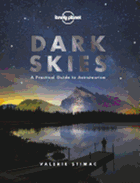
Most of Lonely Planet's guides cover the ground beneath us: hotels and restaurants, landmarks, museums, day trips and everything in between. Many of these destinations suffer from a common plight--light pollution. In his introduction to Dark Skies: A Practical Guide to Astrotourism by Valerie Stimac and Lonely Planet, Phil Plait (aka the Bad Astronomer) cites a study claiming that 80% of the planet is afflicted by light pollution, including 99% of the United States. This means most people can see only a relatively few stars, even on a clear night.
Observing the Milky Way in a place with little or no light pollution can be a life-changing experience. Much of Dark Skies is dedicated to a global listing of sites accredited by the Dark Sky Association for stargazing, such as Cherry Springs State Park in Pennsylvania, Uluru in Australia and NamibRand Nature Reserve in Namibia. Beyond traveling to see the stars, Dark Skies also guides astrotourists to major observatories, rocket launch sites, solar eclipse paths, meteor shower schedules and the best places to see the aurora borealis (despite visa complications, Russia is apparently underrated).
Dark Skies may be a new frontier for Lonely Planet guides, but its format will be familiar to anyone who has used its earthly counterparts. Though many of the destinations are ambitious (good luck seeing Chinese rockets in the Gobi desert), there are enough locations in the Western hemisphere to make Dark Skies worthwhile to U.S. readers, and perhaps it will launch some illuminating trips. --Tobias Mutter, freelance reviewer

